Karnataka SSLC Maths Model Question Paper 4 Kannada Medium is part of Karnataka SSLC Maths Model Question Papers. Here we have given Karnataka SSLC Maths Model Question Paper 4 Kannada Medium.
| Board | KSEEB, Karnataka Board |
| Textbook | KTBS, Karnataka |
| Class | SSLC Class 10 |
| Subject | Maths |
| Paper Set | Model Paper 4 |
| Category | Karnataka Board Model Papers |
Karnataka SSLC Maths Model Question Paper 4 Kannada Medium
ವಿಷಯ : ಗಣಿತ
ಸಮಯ: 3 ಗಂಟೆಗಳು
ಗರಿಷ್ಠ ಅಂಕಗಳು: 80
I. ಕೆಳಗಿನ ಪ್ರಶ್ನೆಗಳಿಗೆ ಅಥವಾ ಅಪೂರ್ಣ ಹೇಳಿಕೆಗೆ ನಾಲ್ಕು ಪರ್ಯಾಯ ಉತ್ತರಗಳನ್ನು ನೀಡಲಾಗಿದೆ. ಇವುಗಳಲ್ಲಿ ಸೂಕ್ತವಾದ ಉತ್ತರವನ್ನು ಆರಿಸಿ, ಕ್ರಮಾಕ್ಷರದೊಡನೆ ಪೂರ್ಣ ಉತ್ತರವನ್ನು ಬರೆಯಿರಿ. (8 × 1 = 8)
Question 1.
ಕೆಳಗಿನ ಸಂಖ್ಯೆಗಳ ಗಣಗಳಲ್ಲಿ ಸಮರೂಪ ತ್ರಿಭುಜಗಳಾಗುವಂತಹ ಜೋಡಿಯು
(A) (3, 4, 6) (9, 12, 24)
(B) (3, 4, 6) (9, 12, 18)
(C) (2,4, 6) (2,3, 14)
(D) (5, 10, 15) (10, 30, 45)
Question 2.
ಚತುರ್ಥಕದ ವಿಸ್ತೀರ್ಣವನ್ನು ಕಂಡುಹಿಡಿಯುವ ಸೂತ್ರ
(A) πr2
(B) \(\frac { 1 }{ 2 }\) πr2
(C) \(\frac { 1 }{ 3 }\) πr2
(D) \(\frac { 1 }{ 4 }\) πr2
Question 3.
(2, 3) ಮತ್ತು (4, 5) ಬಿಂದುಗಳನ್ನು ಸೇರಿಸುವ ರೇಖಾಖಂಡದ ಮಧ್ಯಬಿಂದುವಿನ ನಿರ್ದೇಶಾಂಕಗಳು
(A) (3, 4)
(B) (4, 5)
(C) (5, 6)
(D) (6, 7)
Question 4.
ಧನ ಪೂಣಾಂಕ ‘a’ ಅನ್ನು ಪೂಣಾಂಕ ‘b’ ನಿಂದ ಭಾಗಿಸಿದಾಗ ಅನನ್ಯ ಪೂರ್ಣಾಂಕಗಳಾದ ‘q’ ಮತ್ತು ‘r’ ಗಳು ಇರುತ್ತವೆ. ಇದಕ್ಕೆ ಸರಿಹೊಂದುವ ಹೇಳಿಕೆ.
(A) b = a × q + r
(B) q = a × b + r
(C) a = b × q – r
(D) a = b × q + r
Question 5.
tan260° ಯ ಬೆಲೆ
(A) \(\frac { 1 }{ 3 }\)
(B) \(\frac { 1 }{ \surd 3 }\)
(C) 3
(D) √3
Question 6.
m ನ ಯಾವ ಧನಾತ್ಮಕ ಬೆಲೆಗೆ 3x2 + ka + 3 = 0 ಸಮೀಕರಣದ ಮೂಲಗಳು ಸಮವಾಗಿರುತ್ತವೆ.
(A) 2
(B) 3
(C) 5
(D) 6
Question 7.
ಒಂದು ಪ್ರಯೋಗದ ಎಲ್ಲಾ ಪ್ರಾಥಮಿಕ ಘಟನೆಗಳ ಸಂಭವನೀಯತೆಗಳ ಮೊತ್ತವು
(A) 0
(B) 1
(C) 2
(D) 3
Question 8.
ಒಂದು ಸಿಲಿಂಡರ್ನ ಪಾದದ ವಿಸ್ತೀರ್ಣ 24 cm2 ಮತ್ತು ಎತ್ತರ 10 cm ಆದರೆ ಸಿಲಿಂಡರ್ನ ಘನಫಲ
(A) 24 cm3
(B) 48 cm3
(C) 240 cm3
(D) 480 cm3
II. ಈ ಕೆಳಗಿನ ಪ್ರಶ್ನೆಗಳಿಗೆ ಉತ್ತರಿಸಿ: (6 × 1 = 6)
Question 9.
ಥೇಲ್ಸ್ನ ಪ್ರಮೇಯವನ್ನು ನಿರೂಪಿಸಿ,
Question 10.
135 ಮತ್ತು 225 ರ ಮ.ಸಾ.ಅ. ವನ್ನು ಕಂಡುಹಿಡಿಯಿರಿ.
Question 11.
ಬಹುಪದೋಕ್ತಿ x2 – 3x +5 ರ ಶೂನ್ಯತೆಗಳ ಮೊತ್ತವನ್ನು ಕಂಡುಹಿಡಿಯಿರಿ.
Question 12.
ಬಾಹ್ಯ ಬಿಂದುವಿನಿಂದ ವೃತ್ತಕ್ಕೆ ಎಳೆದ ಸ್ಪರ್ಶಕದ ಉದ್ದವು 8 cm ಮತ್ತು ವೃತ್ತಕೇಂದ್ರ ಹಾಗು ಬಾಹ್ಯಬಿಂದುವಿನ ದೂರ 10 cm ಆದರೆ ವೃತ್ತದ ತ್ರಿಜ್ಯವೆಷ್ಟು?
Question 13.
sin A = \(\frac { 3 }{ 4 }\) ಆದರೆ cosec A ನ ಬೆಲೆಯೇನು?
Question 14.
ಹಂತ ವಿಚಲನಾ ವಿಧಾನದಿಂದ ಸರಾಸರಿಯನ್ನು ಕಂಡುಹಿಡಿಯುವ ಸೂತ್ರವನ್ನು ಬರೆಯಿರಿ.
III. ಈ ಕೆಳಗಿನ ಪ್ರಶ್ನೆಗಳಿಗೆ ಉತ್ತರಿಸಿ: (16 × 2 = 32)
Question 15.
ವಾರ್ಷಿಕ ಸಂಬಳ ₹ 5000 ಮತ್ತು ಪ್ರತಿವರ್ಷಕ್ಕೆ ಹೆಚ್ಚುವರಿ ಬತ್ಯ ₹ 200 ಇರುವ ಕೆಲಸಕ್ಕೆ ಸುಬ್ಬರಾವ್ 1995 ರಲ್ಲಿ ಸೇರಿದರು. ಯಾವ ವರ್ಷದಲ್ಲಿ ಅವರ ಸಂಬಳ ₹ 7000 ಆಗುತ್ತದೆ?
Question 16.
ಚಿತ್ರದಲ್ಲಿ LM || CB ಮತ್ತು LN || CD ಆದರೆ \(\frac { AM }{ AB }\) = \(\frac { AN }{ AD }\) ಎಂದು ಸಾಧಿಸಿ.
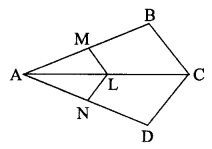
Question 17.
ಈ ಜೋಡಿ ಸಮೀಕರಣಗಳನ್ನು ವರ್ಜಿಸುವ ವಿಧಾನದಿಂದ ಬಿಡಿಸಿ, 3x + 4y = 10 & 2x – 2y = 2.
Question 18.
ಕೆಳಗಿನ ರೇಖಾತ್ಮಕ ಸಮೀಕರಣಗಳ ಜೋಡಿಗಳು ಪ್ರತಿನಿಧಿಸುವ ಸರಳರೇಖೆಗಳು ಒಂದು ಬಿಂದುವಿನಲ್ಲಿ ಛೇದಿಸುತ್ತವೆಯೇ? ಸಮಾಂತರವಾಗಿವೆಯೆ? ಅಥವಾ ಐಕ್ಯಗೊಂಡಿವೆಯೆ? ಕಂಡುಹಿಡಿಯಿರಿ
9x + 3y + 12 = 0; 18x + 6y + 24 = 0.
Question 19.
ಪರಧಿಯು 22 cm ಇರುವ ಒಂದು ಅರ್ಧ ವೃತ್ತದ ವಿಸ್ತೀರ್ಣವನ್ನು ಕಂಡುಹಿಡಿಯಿರಿ.
Question 20.
4 cm ಮತ್ತು 6 cm ತ್ರಿಜ್ಯಗಳಿರುವ ಏಕಕೇಂದ್ರೀಯ ವೃತ್ತಗಳಿವೆ. 6 cm ತ್ರಿಜ್ಯದ ವೃತ್ತದ ಮೇಲಿನ ಒಂದು ಬಿಂದುವಿನಿಂದ 4 cm ತ್ರಿಜ್ಯದ ವೃತ್ತಕ್ಕೆ ಸ್ಪರ್ಶಕವನ್ನು ರಚಿಸಿ.
Question 21.
(2, -5) ಮತ್ತು (-2, 9) ರಿಂದ ಸಮಾನ ದೂರದಲ್ಲಿರುವ x-ಅಕ್ಷದ ಮೇಲಿನ ಬಿಂದುವನ್ನು ಕಂಡುಹಿಡಿಯಿರಿ.
Question 22.
ಶೃಂಗಬಿಂದುಗಳು (1, -3), (4, 1) ಮತ್ತು (2, 3) ಆಗಿರುವ ತ್ರಿಭುಜದ ವಿಸ್ತೀರ್ಣವನ್ನು ಕಂಡುಹಿಡಿಯಿರಿ.
Question 23.
ಶೂನ್ಯತೆಗಳ ಮೊತ್ತ \(\frac { -1 }{ 4 }\) ಮತ್ತು ಗುಣಲಬ್ಧ \(\frac { 1 }{ 4 }\) ಆಗಿರುವ ಒಂದು ವರ್ಗ ಬಹುಪದೋಕ್ತಿಯನ್ನು ಕಂಡುಹಿಡಿಯಿರಿ.
Question 24.
x2 + 6x – 7 = 0 ಸಮೀಕರಣವನ್ನು ವರ್ಗಪೂರ್ಣಗೊಳಿಸುವ ವಿಧಾನದಿಂದ ಬಿಡಿಸಿ.
Question 25.
ಗೋಪುರದ ಪಾದದಿಂದ 30m ದೂರದ ನೆಲದ ಮೇಲಿನ ಒಂದು ಬಿಂದುವಿನಿಂದ, ಗೋಪುರದ ತುದಿಯನ್ನು ನೋಡಿದಾಗ ಉಂಟಾಗುವ ಉನ್ನತ ಕೋನವು 30° ಆದರೆ, ಗೋಪುರದ ಎತ್ತರವನ್ನು ಕಂಡುಹಿಡಿಯಿರಿ.
Question 26.
ಒಂದು ಕಟ್ಟಡದ ಮೇಲಿನಿಂದ ಹಾಗೂ ಕೆಳಗಿನಿಂದ ಬೆಟ್ಟದ ತುದಿಯನ್ನು ಗಮನಿಸಿದಾಗ ಉಂಟಾದ ಉನ್ನತ ಕೋನವು 45° ಮತ್ತು 60° ಆಗಿದೆ. ಕಟ್ಟಡದ ಎತ್ತರ 24 m ಆದರೆ ಬೆಟ್ಟದ ಎತ್ತರವೇನು?
Question 27.
ಈ ಕೆಳಗಿನ ದತ್ತಾಂಶಗಳಿಗೆ ಸರಾಸರಿಯನ್ನು ಕಂಡುಹಿಡಿಯಿರಿ.

ಅಥವಾ
ಈ ಕೆಳಗಿನ ದತ್ತಾಂಶಗಳಿಗೆ ಬಹುಲಕವನ್ನು ಕಂಡುಹಿಡಿಯಿರಿ.

Question 28.
ಒಂದು ಚೀಲದಲ್ಲಿ 3 ಕೆಂಪು ಚೆಂಡುಗಳು ಮತ್ತು 5 ಕಪ್ಪು ಚೆಂಡುಗಳಿವೆ. ಚೀಲದಿಂದ ಯಾದೃಚ್ಛಿಕವಾಗಿ ಒಂದು ಚೆಂಡನ್ನು ತೆಗೆಯಲಾಗಿದೆ. ತೆಗೆದ ಚಂಡು ಕೆಂಪು ಆಗಿರುವ ಸಂಭವನೀಯತೆ ಎಷ್ಟು?
Question 29.
64 cm3 ಘನಫಲವನ್ನು ಹೊಂದಿರುವ 2 ವರ್ಗ ಘನಗಳ ಮುಖಗಳನ್ನು ಸೇರಿಸಿ ಒಂದು ಆಯತ ಘನಾಕೃತಿ ಮಾಡಿದೆ. ಈ ಘನಾಕೃತಿಯ ಮೇಲೈ ವಿಸ್ತೀರ್ಣವನ್ನು ಕಂಡುಹಿಡಿಯಿರಿ.
ಅಥವಾ
14 cm ಎತ್ತರವಿರುವ ಒಂದು ಕುಡಿಯುವ ನೀರಿನ ಗಾಜಿನ ಲೋಟವು ಶಂಕುವಿನ ಭಿನ್ನಕದ ರೂಪದಲ್ಲಿದೆ. ಅದರ ಎರಡು ವೃತ್ತಾಕಾರದ ಪಾದಗಳ ವ್ಯಾಸಗಳು 4 cm ಮತ್ತು 2 cm ಗಳಾಗಿವೆ. ಗಾಜಿನ ಲೋಟ ಸಾಮರ್ಥ್ಯವನ್ನು ಕಂಡುಹಿಡಿಯಿರಿ.
Question 30.
12 ಮತ್ತು 15 ರ ಲ.ಸಾ.ಅ. ಮತ್ತು ಮ.ಸಾ.ಅ. ವನ್ನು ಅವಿಭಾಜ್ಯ ಅಪವರ್ತನ ವಿಧಾನದಿಂದ ಕಂಡುಹಿಡಿಯಿರಿ.
IV. ಈ ಕೆಳಗಿನ ಪ್ರಶ್ನೆಗಳಿಗೆ ಉತ್ತರಿಸಿ: (6 × 3 = 18)
Question 31.
ವೃತ್ತದ ಮೇಲಿನ ಯಾವುದೇ ಬಿಂದುವಿನಲ್ಲಿ ಎಳೆದ ಸ್ಪರ್ಶಕವು, ಸ್ಪರ್ಶ ಬಿಂದುವಿನಲ್ಲಿ ಎಳೆದ ತ್ರಿಜ್ಯಕ್ಕೆ ಲಂಬವಾಗಿರುತ್ತದೆ ಎಂದು ಸಾಧಿಸಿ.
ಅಥವಾ
ಒಂದು ಸಮಾಂತರ ಚತುರ್ಭುಜದಲ್ಲಿ ವೃತ್ತವು ಅಂತಸ್ಥವಾದಾಗ ಸಮಾಂತರ ಚತುರ್ಭುಜವು ವಜ್ರಾಕೃತಿಯಾಗುತ್ತದೆ ಎಂದು ಸಾಧಿಸಿ.
Question 32.
ಪಾದ 8 cm ಮತ್ತು ಎತ್ತರ 4 cm ಇರುವ ಒಂದು ಸಮದ್ವಿಬಾಹು ತ್ರಿಭುಜವನ್ನು ರಚಿಸಿ, ನಂತರ ಮತ್ತೊಂದು ತ್ರಿಭುಜವನ್ನು ಅದರ ಬಾಹುಗಳು ಮೊದಲು ರಚಿಸಿದ ಸಮದ್ವಿಬಾಹು ತ್ರಿಭುಜದ ಅನುರೂಪ ಬಾಹುಗಳ 1\(\frac { 1 }{ 2 }\) ರಷ್ಟಿರುವಂತೆ ರಚಿಸಿ,
Question 33.
ಎರಡು ಕ್ರಮಾಗತ ಬೆಸ ಧನ ಪೂರ್ಣಾಂಕಗಳ ವರ್ಗಗಳ ಮೊತ್ತವು 290 ಆದರೆ ಆ ಪೂಣಾರ್ಂಕಗಳನ್ನು ಕಂಡುಹಿಡಿಯಿರಿ.
ಅಥವಾ
ಒಂದು ಆಯತಾಕಾರದ ಹೊಲದ ಕರ್ಣವು ಅದರ ಚಿಕ್ಕ ಬಾಹುವಿಗಿಂತ 60 m ಹೆಚ್ಚಾಗಿದೆ. ಅದರ ದೊಡ್ಡ ಬಾಹುವು ಚಿಕ್ಕ ಬಾಹುವಿಗಿಂತ 30 m ಹೆಚ್ಚಾಗಿದ್ದರೆ, ಆ ಹೊಲದ ಬಾಹುಗಳ ಉದ್ದಗಳನ್ನು ಕಂಡುಹಿಡಿಯಿರಿ.
Question 34.

ಅಥವಾ
sec A (1 – sin A) (sec A + tan A) = 1 ಎಂದು ಸಾಧಿಸಿ.
Question 35.
ಕೆಳಗಿನ ದತ್ತಾಂಶಗಳಿಗೆ ಓಜೀವ್ ನಕ್ಷೆಯನ್ನು ರಚಿಸಿ, (ಕಡಿಮೆ ವಿಧಾನ)

Question 36.
3x2 – x – 4 ಎಂಬ ಬಹುಪದೋಕ್ತಿಯ ಶೂನ್ಯತೆಗಳನ್ನು ಕಂಡುಹಿಡಿಯಿರಿ ಹಾಗು ಶೂನ್ಯತೆಗಳು ಮತ್ತು ಸಹಗುಣಕಗಳ ನಡುವಿನ ಸಂಬಂಧವನ್ನು ತಾಳೆ ನೋಡಿ.
ಅಥವಾ
x4 – 3x2 + 4x + 5 ನ್ನು x2 + 1 – x ದಿಂದ ಭಾಗಿಸಿ ಭಾಗಲಬ್ದ ಮತ್ತು ಶೇಷವನ್ನು ಕಂಡುಹಿಡಿಯಿರಿ.
V. ಈ ಕೆಳಗಿನ ಪ್ರಶ್ನೆಗಳಿಗೆ ಉತ್ತರಿಸಿ: (4 × 4 = 16)
Question 37.
ಸಮಾಂತರ ಶ್ರೇಢಿಯ ಮೂರು ಪದಗಳ ಮೊತ್ತವು 15 ಮತ್ತು ಅವುಗಳ ಅಂತ್ಯಪದಗಳ ವರ್ಗಗಳ ಮೊತ್ತವು 58 ಆಗಿದೆ. ಶ್ರೇಢಿಯ ಆ ಮೂರು ಪದಗಳನ್ನು ಕಂಡುಹಿಡಿಯಿರಿ.
ಅಥವಾ
ಸಮಾಂತರ ಶ್ರೇಢಿಯ ಮೊದಲ 5 ಪದಗಳ ಮೊತ್ತವು ಮುಂದಿನ 5 ಪದಗಳ ಮೊತ್ತದ ನಾಲ್ಕನೇ ಒಂದು ಭಾಗದಷ್ಟಿದೆ. ಮೊದಲ ಪದ 2 ಆದರೆ, a20 = -112 ಎಂದು ಸಾಧಿಸಿ ಮತ್ತು S20 ನ್ನು ಕಂಡುಹಿಡಿಯಿರಿ.
Question 38.
ಎರಡು ಸಮರೂಪ ತ್ರಿಭುಜಗಳ ವಿಸ್ತೀರ್ಣಗಳ ಅನುಪಾತವು ಅವುಗಳ ಅನುರೂಪ ಬಾಹುಗಳ ವರ್ಗಗಳ ಅನುಪಾತಕ್ಕೆ ಸಮನಾಗಿರುತ್ತದೆ ಎಂದು ಸಾಧಿಸಿ.
Question 39.
ಒಂದು ಬಾವಿಯ ವ್ಯಾಸ 3 m ಮತ್ತು ಆಳ 14 m ಇರುವಂತೆ ತೋಡಿದೆ. ಭೂಮಿಯಿಂದ ತೆಗೆದ ಮಣ್ಣನ್ನು ಬಾವಿಯ ಸುತ್ತಲು ಸಮವಾಗಿ ಹರಡಿ 4 m ಅಗಲವಿರುವ ವೃತ್ತಾಕಾರದ ಕಟ್ಟೆಯನ್ನು ಕಟ್ಟಿದೆ. ಕಟ್ಟೆಯ ಎತ್ತರವನ್ನು ಕಂಡುಹಿಡಿಯಿರಿ.
Question 40.
ನಕ್ಷೆಯ ಮೂಲಕ ಸಮೀಕರಣಗಳನ್ನು ಬಿಡಿಸಿ.
2x + y = 8
x + 2y = 7
Solutions
I.
Solution 1.
(B) (3, 4, 6) (19, 12, 18)
Solution 2.
(D) \(\frac { 1 }{ 4 }\) πr2
Solution 3.
(A) (3, 4)
Solution 4.
(D) a = b × q + r
Solution 5.
(C) 3
Solution 6.
(D) 6
Solution 7.
(B) 1
Solution 8.
(C) 240 cm3
II.
Solution 9.
ತ್ರಿಭುಜದ ಎರಡು ಬಾಹುಗಳನ್ನು ಎರಡು ವಿಭಿನ್ನ ಬಿಂದುಗಳಲ್ಲಿ ಛೇದಿಸುವಂತೆ ಒಂದು ಬಾಹುವಿಗೆ ಸಮಾಂತರವಾಗಿ ಎಳೆದ ಸರಳರೇಖೆಯು ಉಳಿದೆರಡು ಬಾಹುಗಳನ್ನು ಸಮಾನುಪಾತದಲ್ಲಿ ವಿಭಾಗಿಸುತ್ತದೆ.
Solution 10.
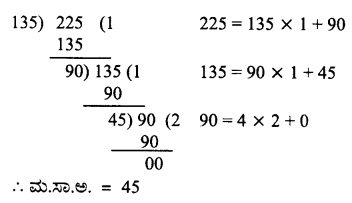
Solution 11.

Solution 12.
OA2 = OP2 – AP2 =102 – 82
⇒ OA2 = 100 – 64
⇒ OA2 = 100 – 64
⇒ OA = √36
⇒ OA = 6 cm
ವೃತ್ತದ ತ್ರಿಜ್ಯ = 6 cm
Solution 13.
cosec A = \(\frac { 4 }{ 3 }\)
Solution 14.

III.
Solution 15.
5000, 5200, 5400, ……… 7000.
a = 5000, d = 200 an = 7000, n = ?
an = a + (n – 1) d
⇒ 7000 = 5000 + (n – 1) 200
⇒ 7000 – 5000 = (n – 1) 200
⇒ 2000 = 200 (n – 1)
⇒ (n – 1) = 10
⇒ n = 10 + 1
⇒ n = 11
11 ನೇ ವರ್ಷದಲ್ಲಿ ಅವರ ಸಂಬಳ ₹ 7000 ಆಗುತ್ತದೆ.
Solution 16.
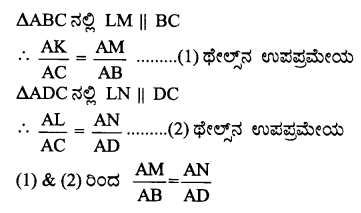
Solution 17.
3x + 4y = 10 …. (1)
2x – 2y = 2 …… (2)
ಸಮೀಕರಣ 2ನ್ನು 2ರಿಂದ ಗುಣಿಸಿದಾಗ
3x + 4y = 10
4x – 4y = 4
…………………
7x = 14
x = 2
3x + 4y = 10
3(2) + 4y = 10
4y = 10 – 6
y = 1
∴ x = 2, y = 1
Solution 18.

Solution 19.
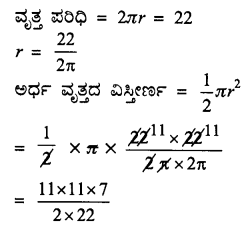
ಅರ್ಧ ವೃತ್ತದ ವಿಸ್ತೀರ್ಣ = \(\frac { 77 }{ 4 }\) cm2
Solution 20.
R = 6 cm, r = 4 cm
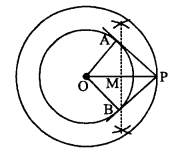
Solution 21.

Solution 22.
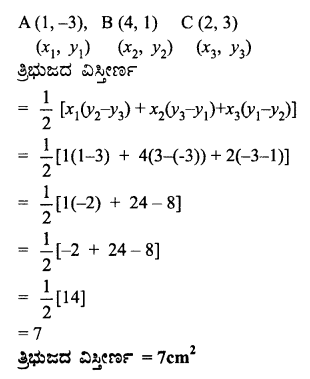
Solution 23.
ಬಹುಪದೋಕ್ತಿ = ax2+ bx + c ಆಗಿರಲಿ
ಶೂನ್ಯತೆಗಳು α ಮತ್ತು β ಆಗಿರಲಿ
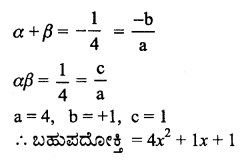
Solution 24.
x2 + 6x – 7 = 0
⇒ x2 + 6x = 7
⇒ x2 + 6x + 32 – 32 = 7
⇒ (x + 3)2 – 9 = 7
⇒ (x + 3)2 = 16
⇒ x + 3 = ±√16
⇒ x + 3 = ±4
⇒ x = ±4 – 3
⇒ x = +4 – 3 ಅಥವಾ x = -4 – 3
⇒ x = 1 ಅಥವಾ x = -7
Solution 25.
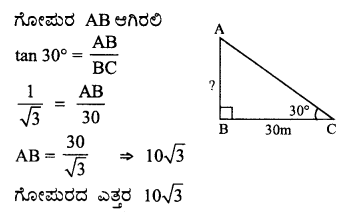
Solution 26.
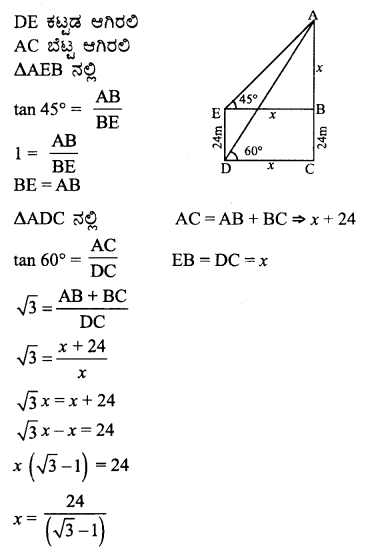

Solution 27.
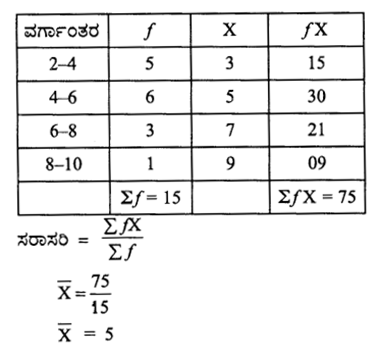
Solution 28.
ಚೀಲದಲ್ಲಿರುವ ಒಟ್ಟು ಚೆಂಡುಗಳು = n(S) = 3 + 5 = 8
ಕೆಂಪು ಚೆಂಡುಗಳು ಸಂಖ್ಯೆ = 3 = n(A)
ಕೆಂಪು ಚೆಂಡು ತೆಗೆಯುವ ಸಂಭವನೀಯತೆ = \(\frac { n(A) }{ n(S) }\)
ಕೆಂಪು ಚೆಂಡು ತೆಗೆಯುವ ಸಂಭವನೀಯತೆ = \(\frac { 3 }{ 8 }\)
Solution 29.
ವರ್ಗಗಳ ಘನಫಲ = 64cm3
ಬಾಹುವಿನ ಅಳತೆ = \(\sqrt [ 3 ]{ 64 }\) = 4 cm
ಆಯತ ಘನದ ಅಗಲ b = 4 cm
ಆಯತ ಘನದ ಉದ್ದ l = 8 cm (4 + 4)
ಆಯತ ಘನದ ಎತ್ತರ h = 4 cm
ಆಯತ ಘನದ ಮೇಲೈ ವಿಸ್ತೀರ್ಣ = 2 (lb + bh + hl)
= 2(8 × 4 + 4 × 4 + 4 × 8)
= 2(32 + 16 + 32)
= 160 cm2
ಆಯತ ಘನದ ಮೇಲೈ ವಿಸ್ತೀರ್ಣ = 160 cm2
ಅಥವಾ
14 cm ಎತ್ತರವಿರುವ ಒಂದು ಕುಡಿಯುವ ನೀರಿನ ಗಾಜಿನ ಲೋಟವು ಶಂಕುವಿನ ಭಿನ್ನಕದ ರೂಪದಲ್ಲಿದೆ. ಅದರ ಎರಡು ವೃತ್ತಾಕಾರದ ಪಾದಗಳ ವ್ಯಾಸಗಳು 4 cm ಮತ್ತು 2 cm ಗಳಾಗಿವೆ. ಗಾಜಿನ ಲೋಟ ಸಾಮರ್ಥ್ಯವನ್ನು ಕಂಡುಹಿಡಿಯಿರಿ.
Solution 30.
12 = 2 × 2 × 5
15 = 3 × 5
ಮ.ಸಾ.ಅ. = 5
ಲ.ಸಾ.ಅ. = 2 × 2 × 3 × 5
ಲ.ಸಾ.ಅ. = 60
IV.
Solution 31.
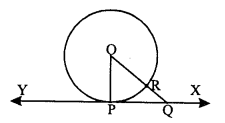
ದತ್ತ: ‘O’ ವೃತ್ತಕೇಂದ್ರ, XY ಸ್ಪರ್ಶಕ, Pಸ್ಪರ್ಶಬಿಂದು
ಸಾಧನೀಯ: OP ⊥ XY
ರಚನೆ: P ಯನ್ನು ಹೊರತುಪಡಿಸಿ XY ಮೇಲೆ ಮತ್ತೊಂದು ಬಿಂದು Q ಆಗಿರಲಿ, OQ ಸೇರಿಸಿ.
ಸಾಧನೆ: OQ ವೃತ್ತವನ್ನು ಬಿಂದುವಿನಲ್ಲಿ ಛೇದಿಸಿದೆ.
OP = OR (ಒಂದೇ ವೃತ್ತದ ತ್ರಿಜ್ಯಗಳು)
OQ = OR + RQ
OQ > OR
OQ > OP (OP = OR)
OP ಯು O ನಿಂದ ಸ್ಪರ್ಶಕಕ್ಕೆ ಕನಿಷ್ಟ ದೂರವಾಗಿದೆ
OP ⊥ XY
ಅಥವಾ
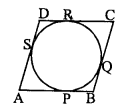
ಸಾಧನೀಯ: ABCD ಒಂದು ವಜ್ರಾಕೃತಿ. (AB = BC = CD = AD)
ಸಾಧನೆ: AB = CD ಮತ್ತು AD = BC …… (1)
AP = AS, BP = BQ, CQ = CR, DS = DR
(ಬಾಹ್ಯಬಿಂದುವಿನಿಂದ ವೃತ್ತಕ್ಕೆ ಎಳೆದ ಸ್ಪರ್ಶಕಗಳು)
AB + CD = AP + PB + DR + CR
⇒ AB + CD = AS + BQ + DS + CQ
⇒ AB + CD = AS + DS + BQ + CQ
⇒ AB + CD = AD + BC
⇒ AB + AB = AD + AD [AB = CD, AD = BC]
⇒ 2AB = 2AD
⇒ AB = AD ….. (2)
∴ AB = BC = CD = AD (ಸಮೀಕರಣ (1) & (2) ರಿಂದ)
Solution 32.
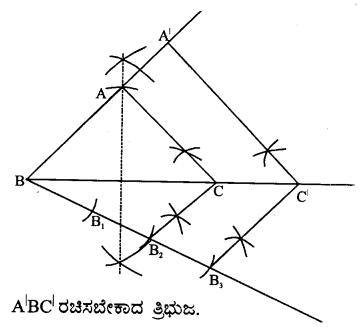
Solution 33.
ಕ್ರಮಾಗತ ಬೆಸ ಧನ ಪೂರ್ಣಾಂಕಗಳು x & x + 2
x2 + (x + 2)2 = 290
⇒ x2 + x2 + 4x + 4 – 290 = 0
⇒ 2x2 + 4x – 286 = 0
⇒ x2 + 2x – 143 = 0
⇒ x2 + 13x – 11x – 143 = 0
⇒ x (x + 13) – 11(x + 13) = 0
⇒ (x + 13) (x – 11) = 0
⇒ x + 13 = 0 ಅಥವಾ x – 11 = 0
⇒ x = -13 ಅಥವಾ x = 11
ಕ್ರಮಾಗತ ಬೆಸ ಧನ ಪೂರ್ಣಾಂಕಗಳು 11 & 13
[∴ x = 11 & x + 2 = 11 + 2 = 13]
ಅಥವಾ
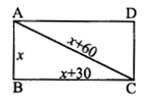
ಚಿಕ್ಕ ಬಾಹು x ಆಗಿರಲಿ
AC2 = AB2 + BC2
⇒ (x + 60)2 = x2 + (x + 30)2
⇒ x2 + 3600 + 120x = x2 + x2 + 900 + 60x
⇒ x2 + 3600 + 120x – 2x2 – 900 – 60x = 0
⇒ -x2 + 2700 + 60x = 0
⇒ x2 – 60x – 2700 = 0
⇒ x2 – 90x + 30x – 2700 = 0
⇒ x (x – 90) + 30 (x – 90) = 0
⇒ x – 90 = 0 ಅಥವಾ x + 30 = 0
⇒ x = 90 ಅಥವಾ x = -30
ಚಿಕ್ಕ ಬಾಹುವಿನ ಉದ್ದ = x = 90 m
ದೊಡ್ಡ ಬಾಹುವಿನ ಉದ್ದ = x + 30 = 90 + 30 = 120 m
Solution 34.
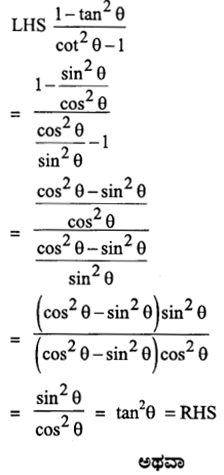
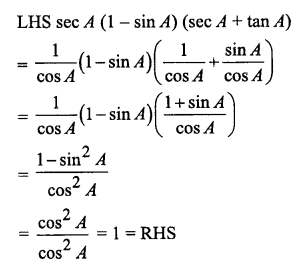
Solution 35.

Solution 36.
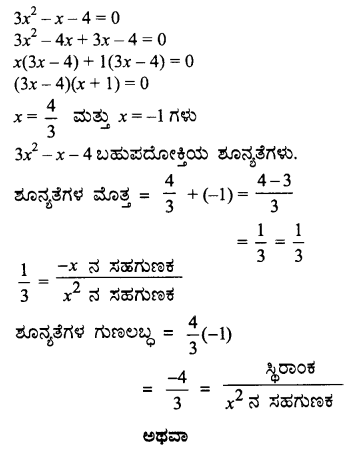
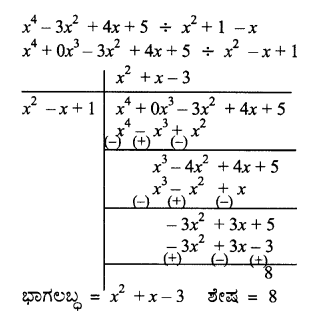
V.
Solution 37.
ಸಮಾಂತರ ಶ್ರೇಢಿಯ ಮೂರು ಪದಗಳು
a – d, a, a + d
a – d + a + a + d = 15
⇒ 3a = 15
⇒ a = 5
(a – d)2 + (a + d)2 = 58
⇒ a2 + d2 – 2ad + a2 + d2 + 2ad = 58
⇒ 2a2 + 2d2 = 58
⇒ 2(a2 + d2) = 58
⇒ a2 + d2 = 29
⇒ 52 + d2 = 29
⇒ d2 = 29 – 25
⇒ d2 = 4
⇒ d = ± 2
⇒ d = 2 ಅಥವಾ d = -2
ಮೂರು ಪದಗಳು
∴ a – d = 5 – 2 = 3
∴ a = 5
∴ a + d = 5 + 2 = 7
ಅಥವಾ
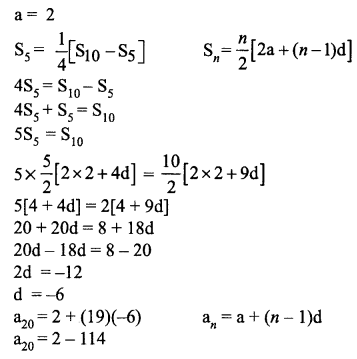
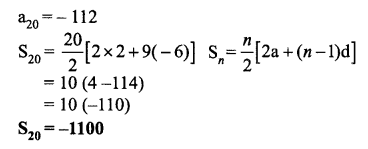
Solution 38.
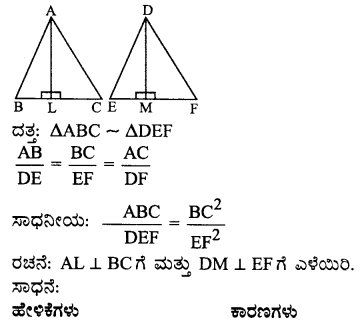
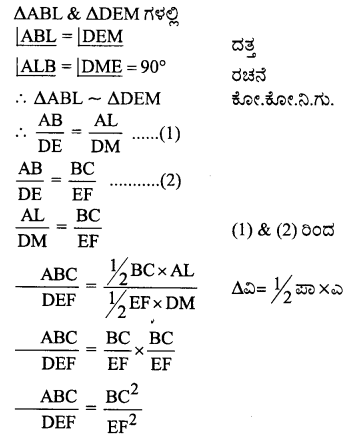
Solution 39.
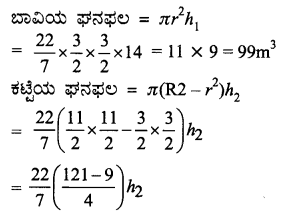
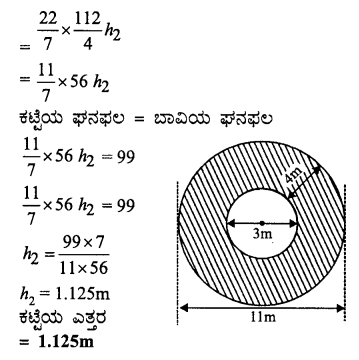
Solution 40.
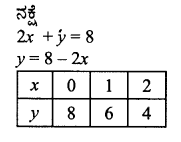
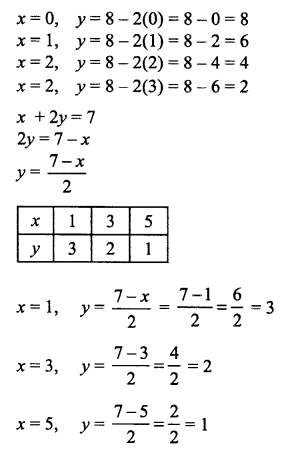
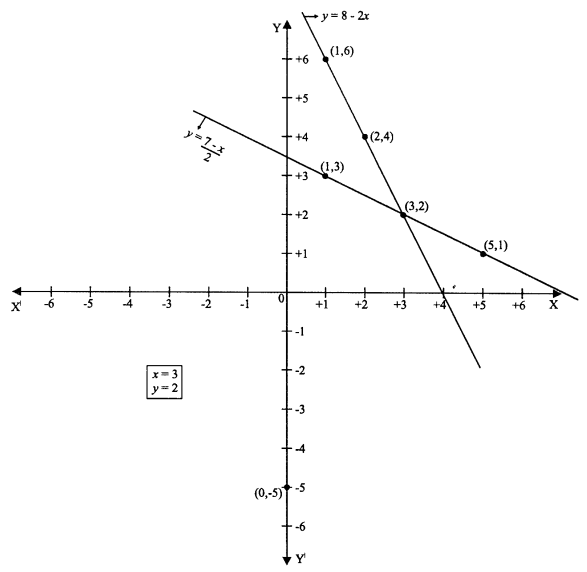
We hope the given Karnataka SSLC Maths Model Question Paper 4 Kannada Medium will help you. If you have any query regarding Karnataka SSLC Maths Model Question Paper 4 Kannada Medium, drop a comment below and we will get back to you at the earliest.





























